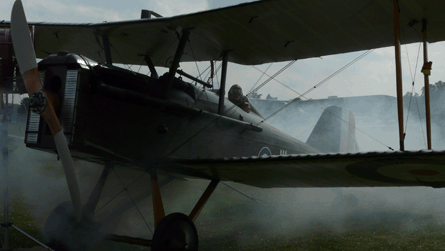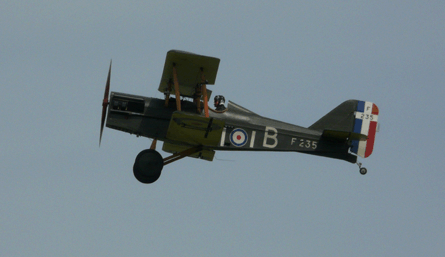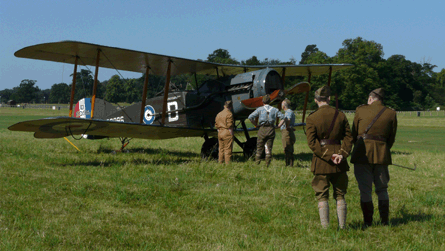Time has not dulled the mystique or romance of First World War dogfights. Nearly 100 years on, the thought of silk scarves, goggles and biplanes in battle still excites us and fill us with ideas of chivalry and valour. The "Red Baron" is a name that continues to command fear and respect.
Writer and director Christopher Spencer wanted to know how it would have felt to have been a young pilot in the Great War, going up against one of the world's deadliest hunters. In his documentary, Fighting the Red Baron, former RAF pilots Mark Cutmore and Andy Offer were invited to fly vintage and replica First World War aircraft and experience first hand the evolution of aerial warfare.
Offer, who flew BAe Harriers in operations in Afghanistan, and Cutmore, who saw active service during the Yugoslavia conflict flying ground attack Sepecat Jaguars, are both ex-Red Arrows, with Offer leading the team in 2000. Now they fly for the Blades Aerobatic Team, which is performing this week at Farnborough.
 |
|---|
© Darlow Smithson Productions |
These lucky top guns were allowed to fly in a vintage Avro 504 and Bristol F.2B from the Shuttleworth Collection, as well as 7/8th scale replicas of an S.E.5 and Junker C.L.1 borrowed from The Great War Display Team. They took to the skies, taking part in mock missions, to find out just what it would have been like to be a pilot in this revolutionary period in aviation.
The Avro 504 was one of the first aircraft to see active service and became a training aircraft. Built by Avro Aircraft, it was the most-produced aircraft of any kind that served in the Great War, but like many aircraft of the conflict, it was incredibly difficult to fly.
"In the early days of the war flying was a very, very dangerous occupation. It was dangerous because the machines were very unreliable. More to the point, the engines were very unreliable," says historian and author of Fighter Heroes of WW1, Joshua Levine, who appears in the documentary.
The Avro forced the pilot to manage the air and fuel mixture in the engine, but it offered an organic flying experience. "It flies beautifully...you could feel every bump, and hear every change in the engine note," says Offer. "I thoroughly enjoyed it."
The aircraft was so new at the beginning of the war that the top brass struggled to see its potential. Its first real use was reconnaissance. In an exciting challenge from the documentary, Cutmore was asked to take reconnaissance photographs in the Bristol F.2B, a two-seater biplane fighter and reconnaissance aircraft. In the rear passenger seat, had to stand up and lean out of the aircraft to take the photo. He and the camera had to be securely harnessed to the aircraft.
If he dropped the camera, it risked tearing the rudder off. The pressure of the experience sent him back to his days in the military. "I have a huge amount of respect for the pilots, especially now that I've had a go at it myself," he says.
 |
|---|
© Darlow Smithson Productions |
The romantic idea of silk scarves and gentlemanly conduct between enemy pilots is not unfounded. At the beginning of the war, pilots waved to each other and, after all, regardless of which side they flew for, they had in common a love of flying. "The one thing that all these people shared was an absolute passion for flying. They wanted to fly," says Levine, but "it didn't take long before they realised they ought to be doing something to stop the other side doing what they were doing."
The nature of flights took a deadly turn. Bullets replaced waves as pilots tried to stop each other taking valuable photographs. Sidearms and shotgun duels were ineffective and rear-passenger machine gunners risked blowing their own tails away.
Levine says: "To make the aircraft into a true fighting machine, what it had to be able to do was to fire forward." The first aircraft to do this was the Fokker Eindecker, and the result was the birth of the fighter as we know it - and German dominance of the skies.
The British response was a new aircraft, the S.E.5, which evened the odds. Behind the controls, Offer found it flew beautifully - and was exceptionally fun to fly: "It's an old, light aeroplane. It's not got controls that have evolved over 60, 70, nearly 100 years. It's very much back to basic controls."
So what would it have been like to fight the Red Baron? Offer, flying the S.E.5 for the British, and Cutmore, playing the German part in a Junker C.L.1 monoplane, battled each other in a classic dogfight to find out. Offer and Cutmore were "shooting" at each other with gun-mounted cameras that recorded the action, and showed Offer to have got the upper hand, with more decisive shots of the cockpit and engine than Cutmore.
Flying in open cockpits was a different experience to the cocoon of a modern fighter. "I found it more exciting than the clinical sort of flying that the military fast jets have become," says Cutmore.
The day gave them a taste of battle over the Western Front, but it could not compare to live, loaded guns that could shred a linen and wood biplane.
On 23 September 1917, 56 Sqn of the Royal Flying Corps took part in the most epic dogfight of the war, against German ace, Werner Voss. With more than 40 kills, Voss was second only to the Red Baron. "Voss is said to have been amazing. He manages to evade six, seven pilots at one time and they said he looked invincible," says Alexandra Churchill, another historian from the documentary. "They were unable to shoot this man down because he was turning so quickly." Adds Levine: "He was carrying out manoeuvres that they had never seen before."
 |
|---|
© Darlow Smithson Productions |
Eventually, however, one young British pilot Lt Arthur Rhys-Davids, managed to get on Voss's tail and shoot him down. The quality of the fight and the flying excited everyone, especially Rhys-Davids, but, Churchill points out: "He wasn't excited about having killed Werner Voss and he is actually quoted as saying: 'If only I could have brought him down alive'. He didn't take any pleasure in killing him."
While Voss died in the cockpit, Cutmore, of course, was able to "lose" and still discuss the day with his "adversary". The deadly air games of 1914-18 were as far from this film duel as nearly 100 years can make it.
But after spending so much time in the air with these classic aircraft, how did the two modern-day pilots feel about their First World War counterparts? Cutmore feels a kinship, saying: "I think there's no difference." Regardless of the time period, it is the same type of man who takes to the sky.
Offer agrees, saying: "I think we would have been similar to how they were. Excitement, definitely, camaraderie with each other. We'd have been all of those things we are today. I think we would have been the same."
DANGEROUS RECONNAISSANCE MISSIONS FROM THE FIRST WORLD WAR
The skies offered unparalleled views of the enemy lines and the aeroplane quickly became used for photo reconnaissance. The Bristol F.2B, manufactured by British and Colonial Aeroplane, was an agile two-seater reconnaissance aircraft. Photo reconnaissance was a dangerous mission requiring the rear-passenger to lean precariously over the side of the aircraft with his camera, while being fired upon, to take pictures.
The Dutch aircraft pioneer, Anton Fokker, fitted the Eindecker with a front-facing machine gun that fired synchronised rounds between the spinning propeller in 1915. There was a window of just a 40th of a second between each blade. "The Fokker Eindeckers, even though they weren't terrific aeroplanes, very nearly blew the British machines out of the sky in 1915," because of the devastating impact of the front-facing gun, says historian Joshua Levine. This gave the Germans a massive air superiority and almost lead to the destruction of the Royal Flying Corps. "The life expectancy of new pilots just plummeted...the life expectancy of someone arriving on the front to their death became 11 days." From July 1915 to early 1916, the Allied aviators regarded their poorly armed aircraft as "Fokker Fodder". It was the birth of the modern day fighter.
The S.E.5 has been considered the Spitfire of the First World War, but not by the pilots who first flew it. Historian Alexandra Churchill says: "For all of the excitement about the S.E.5, it arrives and they hate it." Pilots found it slow and clunky. And that meant life-threatening. Former RAF pilot Andy Offer describes the key things he looks for in a fighter: "You want a big engine, a lot of power, with a light frame. Nice and manoeuvrable, and you want great visibility. The guy who sees [his opponent] first will probably win."
His first impressions of the S.E.5 scared him. "Its got a very flat front, so it's going to be very draggy. I'm looking and thinking there are a lot of bits and pieces around that aeroplane that will restrict your visibility."
Before taking the S.E.5 into combat, the pilots of 56 Sqn stripped out any unnecessary weight, such as armour plating and seat raising mechanisms, and gained 6kt (11km/h) and a speed advantage over the Germans' Albatros, manufactured by Albatros-Flugzeugwerke. This was crucial for survival. The modified S.E.5 was a milestone in aircraft design.
The end of the war in 1918 also signified the end of dogfights. "Dogfights were a very common occurrence of the First World War, but they never really ever happened again," says Levine. Even by the time of the Battle of Britain, aircraft had become too quick and too agile. The time any aircraft was in a gun sight became too brief.
But the idea of classic dogfights are ingrained in our consciousness. "If you watch a science fiction movie now, if you watch Star Wars for example, watch the X-fighters take on the TIE fighters. You'll notice what they're really having is a First World War dogfight. And yet that never really happened again after 1918."
- More images of classic aircraft from the Shuttleworth Collection
- All the latest news, video and images from the 2010 Farnborough air show - New this year, live streaming video of each day's flying display
Source: Flight Daily News
















